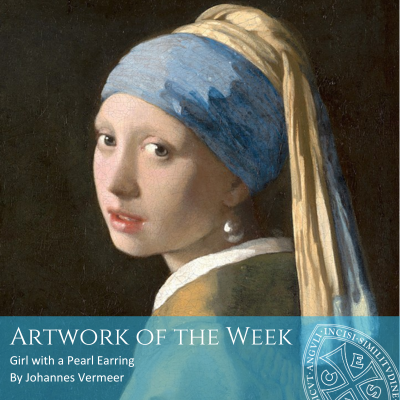‘Girl with a Pearl Earring’ is one painting that continues to intrigue and inspire. Created in the 17th century, this enigmatic portrait of a young girl has left art historians and scholars inspired and mesmerised with its intricate detail and enduring mysteries. Johannes Vermeer, a Dutch Baroque painter, is known for his mastery use of light, shadow, and colour. Born in Delft in 1632, he produced a relatively small but exquisite body of work, and ‘Girl with a Pearl Earring’ stands as one of his most iconic creations. This painting was considered unique for the distinct position of the girl looking back at the viewer, her enigmatic gaze, the colours and the delicate quality of the light.
Painted in 1665, this artwork is renowned for its use of chiaroscuro, a technique that creates a dramatic interplay of light and shadow; this can be observed in the way light falls on the girl’s face and the pearl earring itself. The strong contrast between the illuminated parts of her face and the dark background behind her helps to give her features a lifelike quality and make the pearl earring stand out as a central element of the composition. This contrast contributes to the painting’s enduring allure. The central figure, a young girl, gazes out from the canvas with an aura of gentle mystery. Her turban-like headdress is rendered with incredible attention to detail, as Vermeer captures the folds of the fabric. The light reflects off the smooth parts of the fabric and the more textured, shadowed areas, which adds to the overall sense of realism. The turban is a rich warm-golden yellow colour which contrast with the girl’s pale complexion. This also draws attention to her face and the central pearl earring. The turban-like head covering adds an exotic and somewhat otherworldly quality to the girl’s appearance. It might be a nod to the Dutch fascination with the East Indies and their imported luxury goods. Vermeer’s meticulous attention to detail is evident in the pearls’ appearance. You can see tiny imperfections and irregularities on the pearl’s surface, which only add to its realistic appearance. Some art historians have considered the symbolism behind the pearl earring suggesting that it might symbolize purity, wealth, or even a tear. In this context, the earring could represent the girl’s innocence and the wealth or social status of the household. The earring also draws attention to the girl’s exposed ear, enhancing the intimacy of the moment captured by Vermeer.
The girl’s expression is both vulnerable and inviting, as if she is about to share a profound secret; in this time a “lady” would not have her portrait painted with anything but tightly- drawn lips. One of the most striking features of the girl’s expression is her direct and intense gaze. She looks at the viewer, creating a sense of connection and engagement. Her flawless skin, rosy cheek, and dewy eyes contribute to her overall attractiveness and the sense of idealized beauty. To fully appreciate ‘Girl with a Pearl Earring’, one must understand the historical and cultural context of 17th-century Netherlands. This was the Dutch Golden Age, a period of great economic prosperity and artistic innovation. Vermeer’s works often depicted domestic scenes, and his meticulous attention to detail reflected the Dutch penchant for precision and craftsmanship. Moreover, the emergence of the Dutch Republic as a global trading power meant that exotic goods from distant lands, like pearls, were increasingly available and admired. Vermeer’s decision to paint a young girl wearing a pearl earring likely echo with viewers who appreciated the wealth and cosmopolitanism of their era. ‘Girl with a Pearl Earring’ continues to captivate audiences worldwide, not only for its technical brilliance but also for the aura of mystery it exudes. Johannes Vermeer’s masterpiece invites viewers to ponder the significance of the pearl earring, the identity of the girl and the story behind the painting. Its enduring appeal lies in its ability to evoke curiosity and spark the imagination of those who encounter it, reminding us that great art transcends time, inviting us to explore the depths of human emotion and beauty.
Alexandra De S, Upper Sixth














